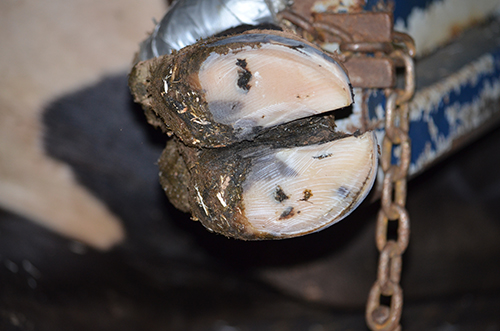
Lameness and hoof health have garnered a great deal of attention in recent years. At the Vita Plus Dairy Summit, veterinarian Gerard Cramer discussed how we can address hoof health globally.
An often-mentioned method is to breed a better cow. "The heritability of hoof health is quite low, which equates to slow progress," noted Cramer. A few countries, such as Holland, do have a claw health index built in to their genetic evaluations. Selection based on this index, though, will only reduce the prevalence by 0.7 percent per year. "It's not the be all, end all," stated Cramer.
Instead, we need to take an integrated approach and adjust our management strategies to reflect the cows we have today.
"An integrated approach begins with getting the producer, hoof trimmer, veterinarian and nutritionist on the same page. This focused intervention starts with lesion data. We have to know what lesions we're dealing with and when in the lactation cycle they're encountered," added Cramer.
Four "success factors" play into reducing lameness prevalence: low infection pressure, good horn quality and shape, low forces on the feet, and early detection.
- Low infection pressure: The primary focus here is foot hygiene. "Alley scrapers are often installed to save labor, yet they create a manure tsunami. The best time to run scrapers is when the cows are out of the pen," noted Cramer. A greater prevalence of digital dermatitis and ulcers is seen with alley scrapers as it bathes the hoof in manure. The goal is to have dry floors and dry hooves.
"The purpose of a footbath on-farm is to prevent lesions, not to treat them," added Cramer. Digital dermatitis cannot be eliminated with a footbath; it needs to be treated. "Producers need to decide what a "manageable" level of lameness is on their dairy and run the footbath often enough to get there," stated Cramer.
The key to footbath success is to maximize contact through design, dimension, frequency of use and, finally, the product you choose to use. "When choosing a product, consider ease of use, cost, environment and human safety. The only products that have solid data behind them are copper sulfate and formalin," he added.
- Good horn quality: "The outside wall will bear the cow's weight. It is the trimmer's job to prevent lameness and trim in a manner that doesn't lead to lameness down the line," noted Cramer.
- Low forces on the feet: "Cow comfort and proper flooring contribute to whether or not cows become lame," said Cramer. "We need to maximize lying times and minimize standing. Cows have better recovery rates in deep-bedded stalls," he continued.
- Early detection and treatment: "When a cow is identified as lame, we need to have a lameness treatment protocol in place and treat the cow within one to two days. If you choose to use tetracycline, you need to talk with your vet about how much to use as it can cause residues," Cramer added

The author, Amanda Smith, is an associate editor and an animal science graduate of Cornell University. Smith covers feeding, milk quality and heads up the World Dairy Expo Supplement. She grew up on a Medina, N.Y., dairy, and interned at a 1,700-cow western New York dairy, a large New York calf and heifer farm, and studied in New Zealand for one semester.








